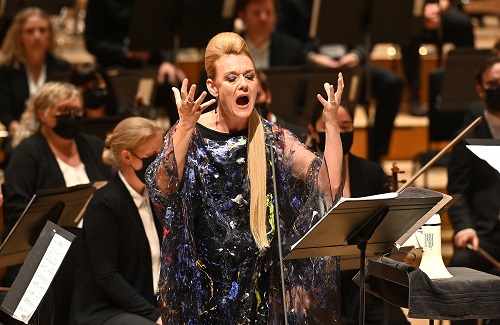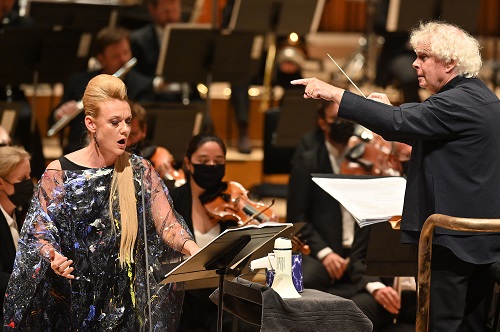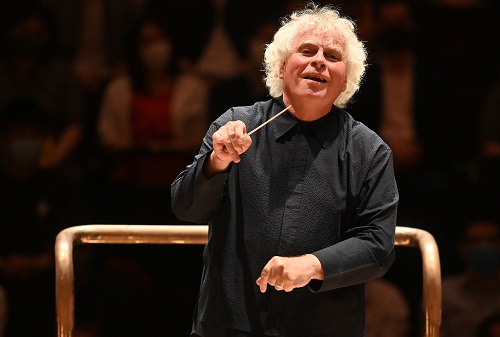An obvious risk, and frustration, in asking infinitely profound questions is that one knows they cannot be answered. The title of Ondřej Adámek’s orchestral song-cycle, Where Are You?, poses one such question, pleading for knowledge of God’s existence, and, implicitly, thus for confirmation of the ‘meaning’ of life. Well, the philosophers are still wrangling about that, and one might be tempted to respond that evidently there is no such ‘meaning’ or man would not have needed to invent religion.
But, putting that aside and acknowledging that man does persist in seeking such answers, a related danger is that in not just seeking for profound knowledge but also in attempting to embody such profundity, one falls flat. The doesn’t stop man – scientists, philosophers, artists – trying, and some – in music one thinks perhaps of J.S. Bach, Beethoven, Bruckner, Mahler – may succeed in intimating and making us feel what we do not and cannot ‘know’.
In a sense, this is what Ondřej Adámek attempts in Where are You?, a joint commission by the Bayerische Rundfunk Musica Viva Festival and the London Symphony Orchestra which received its world premiere earlier this year. Adámek seeks the answer to his question in sound itself, not music or language, but the phenomes that constitute words, as he explains: ‘When I write vocal music, I spend a lot of time on the text. I read it a thousand times loudly, search for its natural flow and look at the text from different perspectives: the meaning of the whole text, the meaning of each verse, of each word, but also the sound of individual syllables and phonemes.’ Such sounds become tactile and kinetic forces. The deconstruction of word into fragments, fragments into syllables, syllables into phenomes, and then the further distortion of those phenomes into ‘pure’ sounds, destroys distinctions between languages, and the connection between sound and linguistic ‘meaning’, effecting a transition from the cerebral to the physical, such that the physical performers and their sounds become the totality and meaning of the work.

Thus, Where are You? seeks its answers not in the various cultures and religions – Judaism, Christianity, Buddhism, Hinduism and Sufism – with which Adámek engages, nor in the various languages (Aramaic, Czech, Spanish, Moravian dialect, English, Sanskrit) or texts (The Bible, Moravian folksong, a traditional Sevillian Easter chant, the Bhagavad Gita) which he has set in the eleven sections of Where are You?, and which form a dramatic continuum. Indeed, though some sections have quite a distinct idiomatic musical flavour, it can be difficult at times to follow the progression of textual explorations (or should that be explosions?) since, as words are deconstructed into breathy whispers, piercing howls, and guttural clicks and clacks, then framed within an orchestral sound-track of onomatopoeic fragments – a sort of surround-sound mosaic built from glissandi and other musical effects, and ‘found sounds’ (Rattle shakes a box, the percussion experiment with aerosol cans) – they collide and coalesce. Instead, at the start of the work it is the soloist – here, the mezzo-soprano Magdalena Kožená for whom the work was composed – who is the meaning.
So, the opening section, ‘Slotha – setting a trap for divine’, begins in ritual fashion. Kožená cupped her hands in front of her face, then extended her arms, accompanying her reaching out with a mantra-like evocation which seemed to summon elemental feelings: pain, loss, anger, love. This first song is based upon Czech translations of the first two words of the Lord’s Prayer in Aramaic (“Awoon dwashmeya’”). The orchestra are silent, and it’s clear that this work will be less an orchestral song-cycle than a dynamic, probing, hyper-sensitive dramatic scena: as the programme explains, Adámek spends two minutes simply exploring the first two phonemes, ‘a’ and ‘w’. Gradually, tentatively, the emitted sounds – hushed breaths, vocal ticks – are picked up by the orchestra, are relayed, echoed, developed.

Sounds evoke contexts too. The second eponymous section is inspired by Chapter 19 (not Chapter 12 as the programme stated) of the First Book of Kings, in which God reveals himself to Elijah after he has smitten the prophets and fled to the wilderness: ‘And he said, “Go forth, and stand upon the mount before the Lord.” And, behold, the Lord passed by, and a great and strong wind rent the mountains, and brake in pieces the rocks before the Lord; but the Lord was not in the wind: and after the wind an earthquake; but the Lord was not in the earthquake.’ Percussive thunder, the strings’ glissandi wind-screech, the horns’ snowy blast, and finally an orchestral ‘landslide’ evoked Elijah’s internal monologue – “I’m looking for You in lightning,/ In thunder, in hailstorm … You’re not in earthquake. In snowstorm, in blizzard, in avalanche?” – as Magdalena Kožená’s elongated syllables and stuttering repetitions complemented the instrumentalists’ pictorial soundscape.
Elijah has believed that he encounters God in such dramatic manifestations. God understands that Elijah’s depression will be lifted through a personal encounter with Him. And so, ‘the Lord was not in the earthquake; and after the earthquake a still small voice’: a ‘still small voice’ that speaks to Elijah’s human heart. Adámek does not allow us to share in Elijah’s humble experience of God’s presence, however; instead, his questions lead him to wonder whether God can be found in song, in dance, “In wine!” – thoughts which lead to the adaptation of a Moravian dialect folksong in which a couple of music-loving drinkers are led by “holy angels, all of them with horns” to Paradise, into which they are denied entry by Peter. Texts intrude upon other texts, and into this raucous folksy tale abstract words from the Life of St Teresa of Avila are interjected, in Czech: “delight … sweetness …/ … deliciousness …/ whiteness … pain.”
There are false gurus, too, in the section entitled ‘Sharp Point’ where the sound-world becomes sparse and intensely focused, and then a ‘Confession’ in which Rattle’s tiny, precise baton movements evoked the interiority of St Teresa’s words as they tumbled and echoed against harp and bass drum. Kožená’s absolute commitment, and vocal and dramatic surety, were astonishing, and I was interested to find Adámek commenting that there were passages where “Magdalena was hoping to have more ‘singing’ in the piece and I was again insisting on a half-whispered voice, low register, pronunciation of each phoneme, strict rhythm like beat-boxing.’ The mezzo-soprano had her chance to ‘sing’ in St Teresa’s ‘Ecstasy’ in which instrumental pictorialism – the harp, piccolo, double bass and xylophone slicing as the angel thrust the spears into the martyr’s heart – closed with quasi-rapture: “He draws out my entrails/ Leaving me all on fire/ Of divine love/ Sweet pain/ Delicious pain/ Beautiful pain.” And, again, in the lyricism of the ‘Gentle Whisper’ in which the divine is manifest in the air, in light, in sound.
In the closing section – a chant-like hymn of praise setting text from the Bhagavad Gita, sung in English before transmuting to Aramaic – Kožená turned her back on the audience, reaching forwards towards the musicians. It was an apt gesture as, ultimately, Kožená alone unified this work, through her extraordinary focus, precision and commitment. Adámek juxtaposes different idioms – the Moorish magic of a Sevillian Easter song, the verve of American music theatre, the indelicacy of a Moravian folk song – but such contrasts do not create tensions that help to elucidate the structure of the whole. Rather they are just contrasts. The composer is fortunate to have Kožená, and Rattle and the LSO, to bring them together.

The decision to programme Beethoven’s ‘Pastoral’ Symphony alongside Adámek’s soundscape was a masterstroke. There were more questions here; but, of the leisurely, open-ended kind. Shall we take this turn, or that? Where might this path lead us? The route may not have been known but the destination was unwavering. Such conversations were held across the whole orchestra, every player a participant. Rattle’s tempi were not slow, but they were not brisk either: spacious, easy, comfortable – genteel, perhaps, as the aristocratic ramblers pondered their route. Developing harmonies seems to be assessed, and accepted, and followed. Bucolic exuberance was balanced by delicacy. At times Rattle was happy to let his musicians meander; elsewhere, he was the storm incarnate.
Beethoven knew that Nature – however sublime in the Romantics’ eyes – simply ‘is’: perhaps it is ‘divine’, but if we cannot know how and why, we can understand that it reassures. The apocalyptic thunder and the bird’s gentle warble assuage equally.
Claire Seymour
Ondřej Adámek – Where are You? (UK premiere); Ludwig van Beethoven – Symphony No 6, ‘Pastoral’
Magdalena Kožená (mezzo-soprano), Sir Simon Rattle (conductor), London Symphony Orchestra
Barbican Hall, London; Thursday 16th September 2021.
ABOVE: Magdalena Kožená and and the LSO, conducted by Sir Simon Rattle (c) Mark Allan